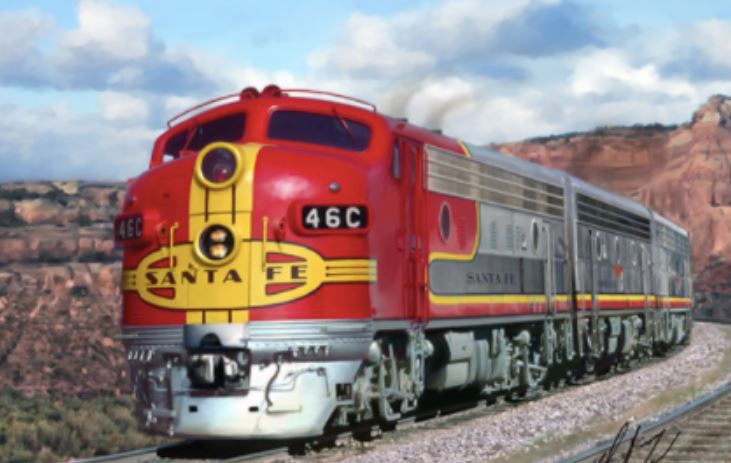The Super Chief

It is a holiday weekend. Marlow started us off this morning with an account of train travel. Many of us ride something like the rails in our clustered cities. “Light rail,” they tell us, a replacement for the old heavy-gauge universal track that opened our land before the arrival of the automobile and the superhighway. According to the family records, after landing in Baltimore, we had men swinging hammers building the Alexandria & Orange railroad that runs by Refuge Farm. With that work complete at Gordonsville, there was more work to help push the rails west to Nashville. The hammer-swinger in Mom’s line didn’t make it, dying on the job and leaving his Irish contribution to the soil of Tennessee.
Grandpa on her side had demonstrated upward mobility. His career wasn’t swinging steel, but driving the big locomotives himself. An Engineer. We had a good run with them, but the family left the rails when he passed almost eighty years ago.
I was driving over to the pool complex for part of the weekly fitness routine and saw some people doing the usual slightly aberrant things on the road. Can you imagine trying to introduce the concept of the independent motor vehicle in today’s America? The freedom of any individual with the means to simply walk out of their house, hop in the car, turn the ignition and go wherever you please, whenever you wish?
Need more range? Ten minutes on a fill-up just about anywhere.
That is a sort of liberty that would be viewed with suspicion and distrust now. In fact, from an evolutionary perspective, it would be preferable to some that the progression would be reversed, and that mass transit would be achieved by a centralized system, more easily controlled by a strong central planning authority to replace individual choice. Something like what we have now would never be permitted today. Too free. Too subject to personal desire. Selfish.
Back in the day, our pal George wound up going to school out in New Mexico, and with a lull in my schedule, I decided to take one of the Amtrak trains that used to have a name out to see him. I picked up the train that ran across southern Michigan toward that magical windy city of Chicago. There, I fumbled around in the station to find the line west, and embarked within it for the long ride across America.
I had no idea this particular train was something special. It was just the train that still went somewhere I wanted to go. It turned out to be much more. I discovered that surprising fact when struck up a conversation with the porter responsible for the car in which my ticket placed me. He was an interesting guy of a certain age who remembered the proud name and the people who used it. His life included a periodic involvement with a show-business person named Jack Benny who did not trust the new airliners to travel between engagements in New York and LA. He reserved a cabin for his personal use each week, east and west. “Just in case.”
It turned out this train had been not only The Chief, but “The Train of the Stars.” It was not just due to Mr. Benny’s preference in locomotion, but because of the panoply of celebrities it carried on the leg of steel between the city under the sun in LA to the city under wind on the big lake in Chicago. It was a historic ride. In its time, it had been the first diesel-electric cross-country train in America, serving the famed Acheson-Topeka & Santa Fe line that ran more than two thousand miles from Dearborn Station in Chicago to LA in just under 37 hours. A pleasant day and a half on the magic steel rails.
That is about what it would take to drive it, if you had a handful of amphetamines, but I wasn’t in the mood for wide-eyed direct travel on four wheels. Mr. Benny, and just wanted to get to Albuquerque. The Chief ran from 1936 with weekly service from both west and eastern terminals. In 1938, it became twice weekly and daily service in the post-war boom year of 1948. It featured gourmet meals in the dining car and an exclusive clientele.
By the time I saw it, the Super Chief was just an Amtrak train. But the Santa Fe Super Chief was one of the last passenger trains in the United States to carry an all-Pullman bill of lading until the end of Santa Fe passenger operations on May 1, 1971. That was a way to travel, delivering talent to microphones well-rested and delightfully-served.
There wasn’t any of that on the Amtrak train I was riding, and the available food average. Sharing the memories of the old porter suggested that travel used to be something better than reaching back from the driver’s seat to fish around in the cooler for something fresh, bubbly and cold and looking for the next hill to cross.
Copyright 2021 Vic Socotra
www.vicsocotra.com
